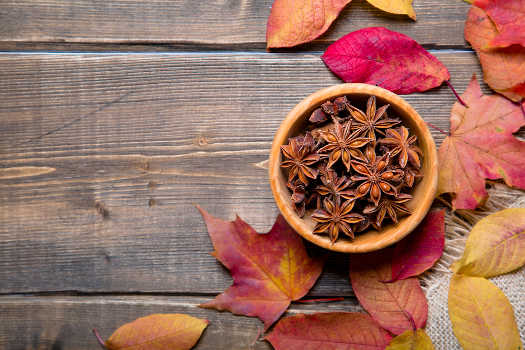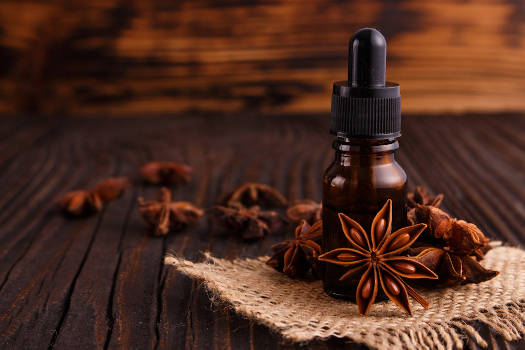Star anise (Illicium verum) is one of the most distinctive herbs in a witch’s cabinet. With its striking star-shaped pods and warm, spicy fragrance, it’s easy to see how it grew to be so highly prized.
Magical Properties of Star Anise
Star anise is native to China, so it doesn’t have a very long magical tradition in European-based witchcraft. Nonetheless, modern witches and herb workers have found a lot of value in these spicy, star-shaped pods.
Star anise is used for luck, prosperity, protection, psychic awareness, and power. When carried, it protects against the evil eye and serves as a luck talisman. Some people make garlands of it for home protection.
Some diviners burn star anise pods on charcoal when scrying, reading tarot, or using other divination tools. It’s also a useful incense for any activity that would benefit from a boost to one’s clairvoyance and psychic abilities.
Some witches include it in incense blends for the new moon, or brew it into a tea with other clairvoyance-enhancing herbs. Some witches keep star anise pods on their altars.
Star anise is ruled by Jupiter, the Moon, and the element of air. Astrologically, it corresponds to Sagittarius and Pisces.
See also: Check out Star Anise seeds and pods here, and Star Anise essential oils here.
Benefits & Uses
Star anise has a long history of use as a culinary and medicinal herb. In herbal medicine, it’s a carminative — meaning that it aids digestion by combating gas. It’s used to stimulate appetite, soothe indigestion, and fight flatulence.
Star anise is a major source of shikimic acid, a potent antiviral. This compound is a precursor to the pharmaceutical medication oseltamivir, better known as Tamiflu, used to treat and prevent influenza infections.
For this reason, it’s also often included in home remedies for teas to ease cold and flu symptoms.

The herb also contains the compound anethole, which is antifungal, and various antibacterial chemicals. Some studies have found that extracts of star anise are able to combat antibiotic-resistant bacteria.
Possible Risks & Side Effects
As with any herb, allergies are possible. Symptoms of an allergy can run the gamut from a mild rash, to anaphylaxis. Don’t consume star anise if you’re allergic to it — substitute a different herb instead.
Only one star anise, the Chinese star anise (Illicum verum), is safe to ingest. Japanese star anise (Illicium anisatum) is an extremely poisonous lookalike.
If Japanese star anise is consumed, it can cause inflammation to the kidneys, bladder, and urinary tract, as well as seizures and hallucinations.
Japanese star anise fruits look very much like Chinese star anise, but are smaller and not as strongly scented. When dried, the seed pods are visually identical, which has lead to a number of product recalls after manufacturers discovered that their teas and spices were contaminated with Japanese star anise. Do not consume any star anise if you aren’t able to verify its species.
Since star anise is a carminative, some people give it to infants to help with colic. This has led to a number of accidental poisonings.
Star anise essential oil can irritate the skin when applied topically. Never apply any essential oil neat, always dilute it with a carrier oil like coconut, jojoba, or grapeseed first.
History & Folklore
This herb has been used in China for over 3,000 years. Like the four-leafed clover in Europe, it was considered lucky to find a star anise with more than eight intact pods. Carrying one was also believed to keep evil at bay.
During the 17th century spice trade, star anise pods made their way into Europe. While still not widely used in European cuisine, Mediterranean countries loved its carminative properties.
It was included as a medicinal ingredient and flavoring agent in many apéritifs and digestifs — alcoholic beverages intended to be drunk before or after meals.
Getting Started With Star Anise
Don’t let the warnings about Japanese star anise scare you off of this valuable, beautiful herb. If you can verify that the star anise you have is truly Illicum verum, you’ll be fine.
Japanese star anise is also only dangerous when taken internally, so you don’t need to worry if you don’t consume it.
The easiest way to get started with star anise is to simply try carrying a dried pod with you. Many metaphysical shops and spice dealers sell whole pods.

Select a pod with five points, to represent the elements and the star of the pentagram, or more than eight points, due to its traditional associations with luck. Hold it in your dominant hand, and visualize it filling with warm, golden light. Ask the pod to protect you and bring you luck. Place it in a cloth pouch, and keep the pouch with you.
Star anise is also an excellent loose incense for beginners. It smells delightful, and doesn’t require any special preparation.
Fill a fireproof incense bowl with sand, and place a lit piece of incense charcoal on top. Set the star anise on the charcoal, and it will produce lots of spicy, sweet-scented smoke.
If you have a bonfire or fireplace, you can also toss star anise pods in the flames to enjoy their scent. If you aren’t able to burn anything, you can add star anise pods to a simmer pot.
Place cinnamon sticks, star anise, vanilla, clove, orange peel, and other strongly-scented herbs in a pot of water, and allow it to simmer on very low heat. It will produce fragrant steam.
Even though star anise is relatively new to European witchcraft, it has its place. Witches are resourceful, and few would turn down the opportunity to work with an herb as delightful as the star anise.
With its associations with luck and protection, it’s the perfect herb to keep around or sneak into dishes of potpourri for some subtle magic.
As an Amazon Associate, Terravara earns from qualifying purchases at no additional cost to readers.
